The Coq Proof Assistant
A Tutorial
April 19, 2011
Version 8.3pl2
Gérard Huet, Gilles Kahn and Christine Paulin-Mohring
The Coq Development Team
�
V8.3pl2, April 19, 2011
cINRIA 1999-2004 (COQ versions 7.x)
cINRIA 2004-2010 (COQ versions 8.x)
�
Getting started
COQ is a Proof Assistant for a Logical Framework known as the Calculus of Induc-
tive Constructions. It allows the interactive construction of formal proofs, and also
the manipulation of functional programs consistently with their specifications. It
runs as a computer program on many architectures. It is available with a variety of
user interfaces. The present document does not attempt to present a comprehensive
view of all the possibilities of COQ, but rather to present in the most elementary
manner a tutorial on the basic specification language, called Gallina, in which for-
mal axiomatisations may be developed, and on the main proof tools. For more
advanced information, the reader could refer to the COQ Reference Manual or the
Coq’Art, a new book by Y. Bertot and P. Castéran on practical uses of the COQ
system.
Coq can be used from a standard teletype-like shell window but preferably
through the graphical user interface CoqIde1.
Instructions on installation procedures, as well as more comprehensive docu-
mentation, may be found in the standard distribution of COQ, which may be ob-
tained from COQ web site http://coq.inria.fr.
In the following, we assume that COQ is called from a standard teletype-like
shell window. All examples preceded by the prompting sequence Coq < represent
user input, terminated by a period.
The following lines usually show COQ’s answer as it appears on the users
screen. When used from a graphical user interface such as CoqIde, the prompt is
not displayed: user input is given in one window and COQ’s answers are displayed
in a different window.
The sequence of such examples is a valid COQ session, unless otherwise spec-
ified. This version of the tutorial has been prepared on a PC workstation running
Linux. The standard invocation of COQ delivers a message such as:
unix:~> coqtop
Welcome to Coq 8.3 (October 2010)
Coq <
The first line gives a banner stating the precise version of COQ used. You
1Alternative graphical interfaces exist: Proof General and Pcoq.
3
�
4
should always return this banner when you report an anomaly to our bug-tracking
system http://coq.inria.fr/bugs
�
Chapter 1
Basic Predicate Calculus
1.1 An overview of the specification language Gallina
A formal development in Gallina consists in a sequence of declarations and defini-
tions. You may also send COQ commands which are not really part of the formal
development, but correspond to information requests, or service routine invoca-
tions. For instance, the command:
Coq < Quit.
terminates the current session.
1.1.1 Declarations
A declaration associates a name with a specification. A name corresponds roughly
to an identifier in a programming language, i.e. to a string of letters, digits, and a
few ASCII symbols like underscore (_) and prime (’), starting with a letter. We use
case distinction, so that the names A and a are distinct. Certain strings are reserved
as key-words of COQ, and thus are forbidden as user identifiers.
A specification is a formal expression which classifies the notion which is being
declared. There are basically three kinds of specifications: logical propositions,
mathematical collections, and abstract types. They are classified by the three basic
sorts of the system, called respectively Prop, Set, and Type, which are themselves
atomic abstract types.
Every valid expression e in Gallina is associated with a specification, itself a
valid expression, called its type τ(E). We write e : τ(E) for the judgment that e is
of type E. You may request COQ to return to you the type of a valid expression by
using the command Check:
Coq < Check O.
0
: nat
5
�
6
CHAPTER 1. BASIC PREDICATE CALCULUS
Thus we know that the identifier O (the name ‘O’, not to be confused with
the numeral ‘0’ which is not a proper identifier!) is known in the current context,
and that its type is the specification nat. This specification is itself classified as a
mathematical collection, as we may readily check:
Coq < Check nat.
nat
: Set
The specification Set is an abstract type, one of the basic sorts of the Gal-
lina language, whereas the notions nat and O are notions which are defined in the
arithmetic prelude, automatically loaded when running the COQ system.
We start by introducing a so-called section name. The role of sections is to
structure the modelisation by limiting the scope of parameters, hypotheses and
definitions. It will also give a convenient way to reset part of the development.
Coq < Section Declaration.
With what we already know, we may now enter in the system a declaration, corre-
sponding to the informal mathematics let n be a natural number.
Coq < Variable n : nat.
n is assumed
If we want to translate a more precise statement, such as let n be a positive
natural number, we have to add another declaration, which will declare explicitly
the hypothesis Pos_n, with specification the proper logical proposition:
Coq < Hypothesis Pos_n : (gt n 0).
Pos_n is assumed
Indeed we may check that the relation gt is known with the right type in the
current context:
Coq < Check gt.
gt
: nat -> nat -> Prop
which tells us that gt is a function expecting two arguments of type nat in
order to build a logical proposition. What happens here is similar to what we are
used to in a functional programming language: we may compose the (specification)
type nat with the (abstract) type Prop of logical propositions through the arrow
function constructor, in order to get a functional type nat->Prop:
Coq < Check (nat -> Prop).
nat -> Prop
: Type
�
1.1. AN OVERVIEW OF THE SPECIFICATION LANGUAGE GALLINA
7
which may be composed one more times with nat in order to obtain the type
nat->nat->Prop of binary relations over natural numbers. Actually the type
nat->nat->Prop is an abbreviation for nat->(nat->Prop).
Functional notions may be composed in the usual way. An expression f of
type A → B may be applied to an expression e of type A in order to form the ex-
pression ( f e) of type B. Here we get that the expression (gt n) is well-formed
of type nat->Prop, and thus that the expression (gt n O), which abbreviates
((gt n) O), is a well-formed proposition.
Coq < Check gt n O.
n > 0
: Prop
1.1.2 Definitions
The initial prelude contains a few arithmetic definitions: nat is defined as a math-
ematical collection (type Set), constants O, S, plus, are defined as objects of types
respectively nat, nat->nat, and nat->nat->nat. You may introduce new defini-
tions, which link a name to a well-typed value. For instance, we may introduce the
constant one as being defined to be equal to the successor of zero:
Coq < Definition one := (S O).
one is defined
We may optionally indicate the required type:
Coq < Definition two : nat := S one.
two is defined
Actually COQ allows several possible syntaxes:
Coq < Definition three : nat := S two.
three is defined
Here is a way to define the doubling function, which expects an argument m of
type nat in order to build its result as (plus m m):
Coq < Definition double (m:nat) := plus m m.
double is defined
This introduces the constant double defined as the expression fun m:nat =>
plus m m. The abstraction introduced by fun is explained as follows. The ex-
pression fun x:A => e is well formed of type A->B in a context whenever the
expression e is well-formed of type B in the given context to which we add the
declaration that x is of type A. Here x is a bound, or dummy variable in the ex-
pression fun x:A => e. For instance we could as well have defined double as
fun n:nat => (plus n n).
Bound (local) variables and free (global) variables may be mixed. For instance,
we may define the function which adds the constant n to its argument as
�
8
CHAPTER 1. BASIC PREDICATE CALCULUS
Coq < Definition add_n (m:nat) := plus m n.
add_n is defined
However, note that here we may not rename the formal argument m into n without
capturing the free occurrence of n, and thus changing the meaning of the defined
notion.
Binding operations are well known for instance in logic, where they are called
quantifiers. Thus we may universally quantify a proposition such as m > 0 in order
to get a universal proposition ∀m· m > 0. Indeed this operator is available in COQ,
with the following syntax: forall m:nat, gt m O. Similarly to the case of the
functional abstraction binding, we are obliged to declare explicitly the type of the
quantified variable. We check:
Coq < Check (forall m:nat, gt m 0).
forall m : nat, m > 0
: Prop
We may clean-up the development by removing the contents of the current section:
Coq < Reset Declaration.
1.2
Introduction to the proof engine: Minimal Logic
In the following, we are going to consider various propositions, built from atomic
propositions A,B,C. This may be done easily, by introducing these atoms as global
variables declared of type Prop. It is easy to declare several names with the same
specification:
Coq < Section Minimal_Logic.
Coq < Variables A B C : Prop.
A is assumed
B is assumed
C is assumed
We shall consider simple implications, such as A → B, read as “A implies B”.
Remark that we overload the arrow symbol, which has been used above as the
functionality type constructor, and which may be used as well as propositional
connective:
Coq < Check (A -> B).
A -> B
: Prop
Let us now embark on a simple proof. We want to prove the easy tautology
((A → (B → C)) → (A → B) → (A → C). We enter the proof engine by the com-
mand Goal, followed by the conjecture we want to verify:
Coq < Goal (A -> B -> C) -> (A -> B) -> A -> C.
1 subgoal
�
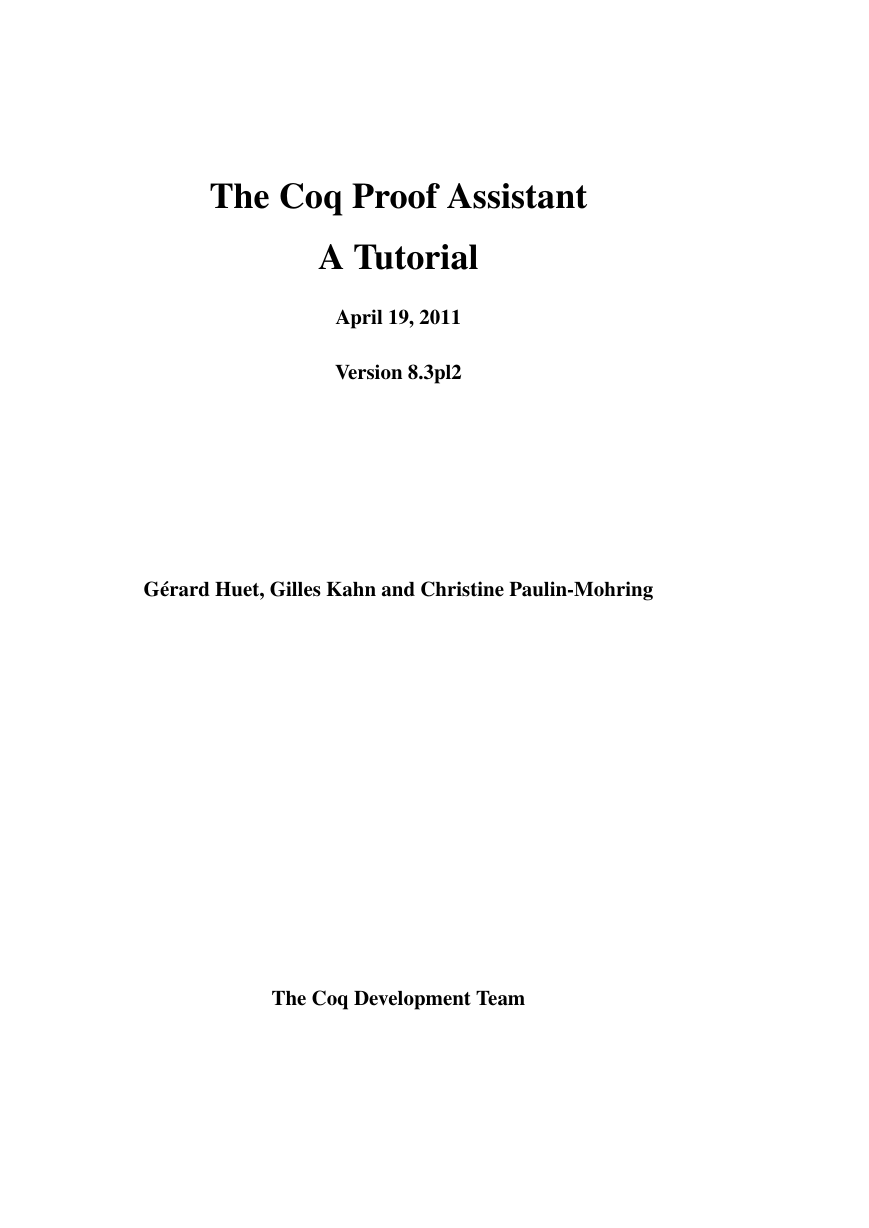

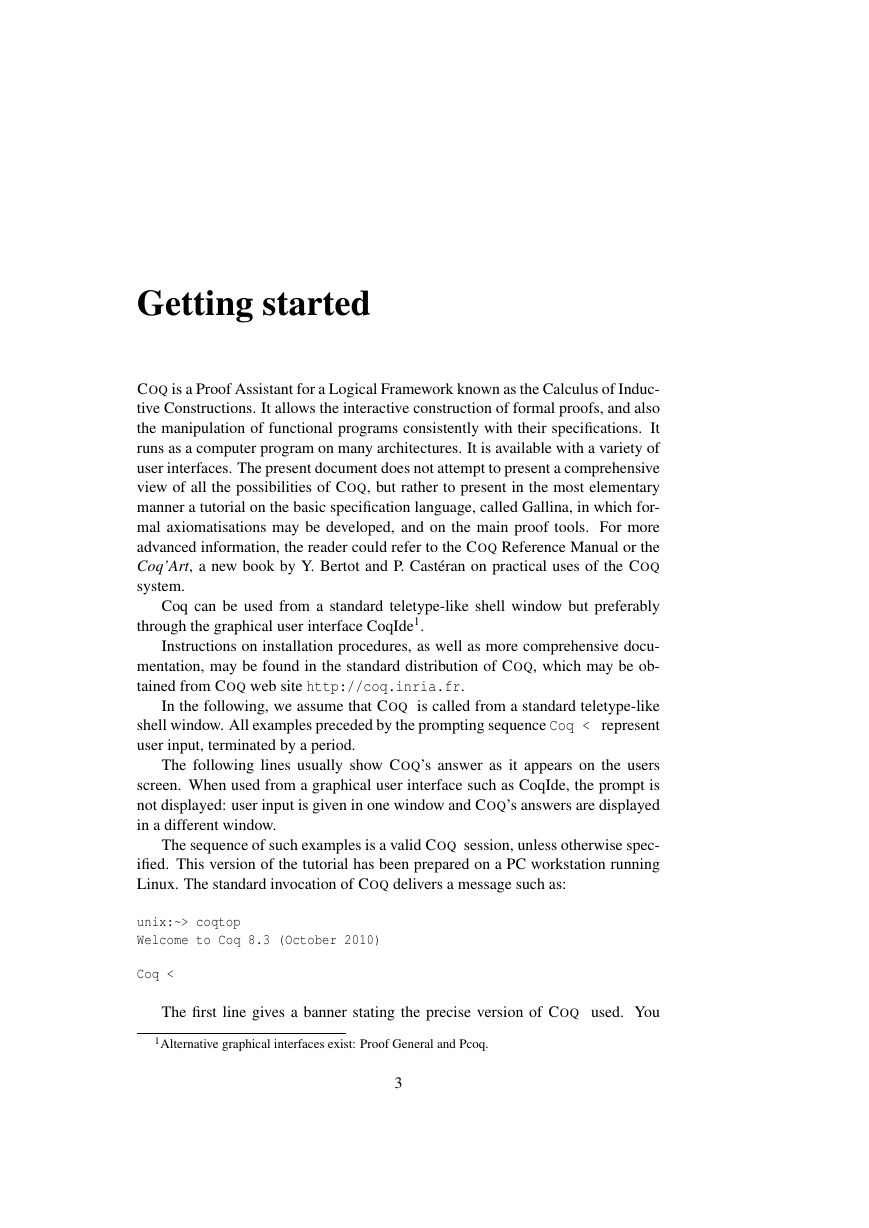

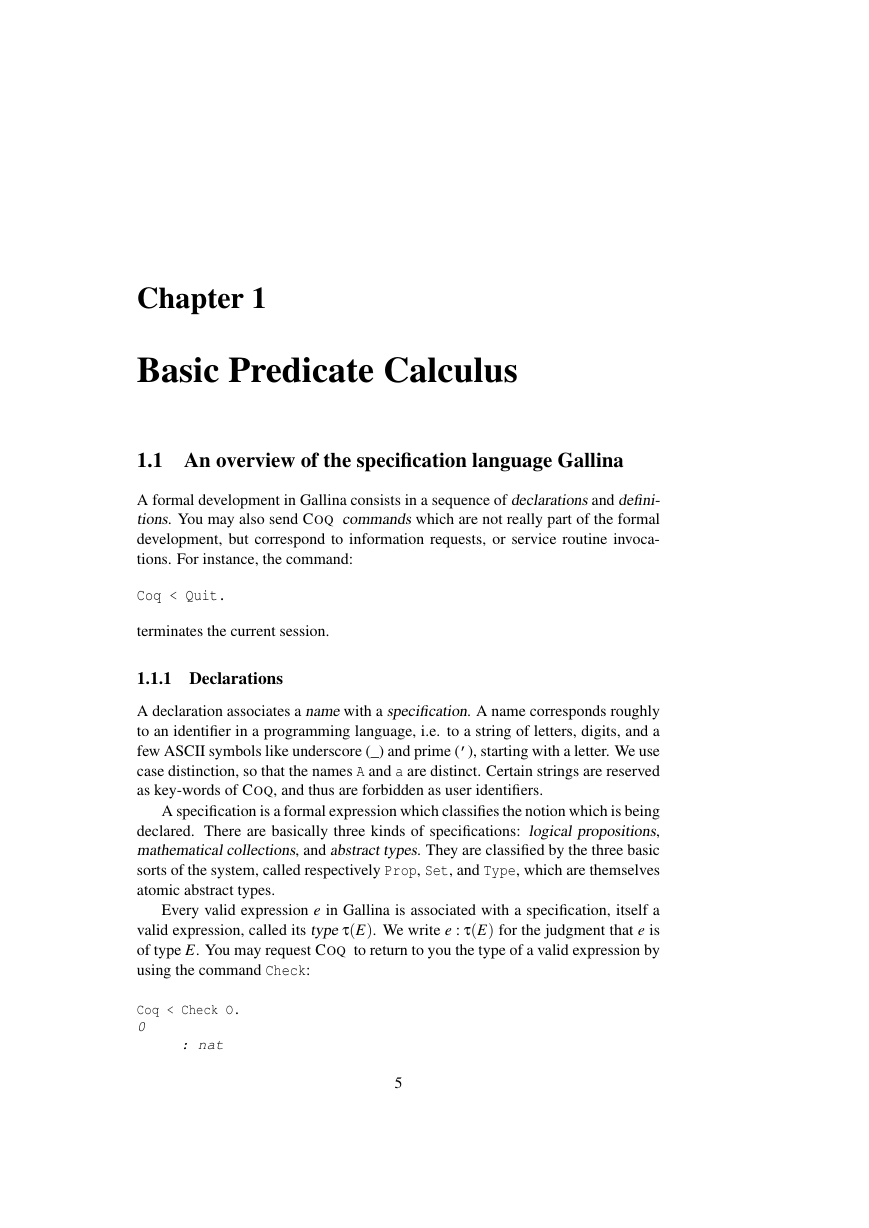
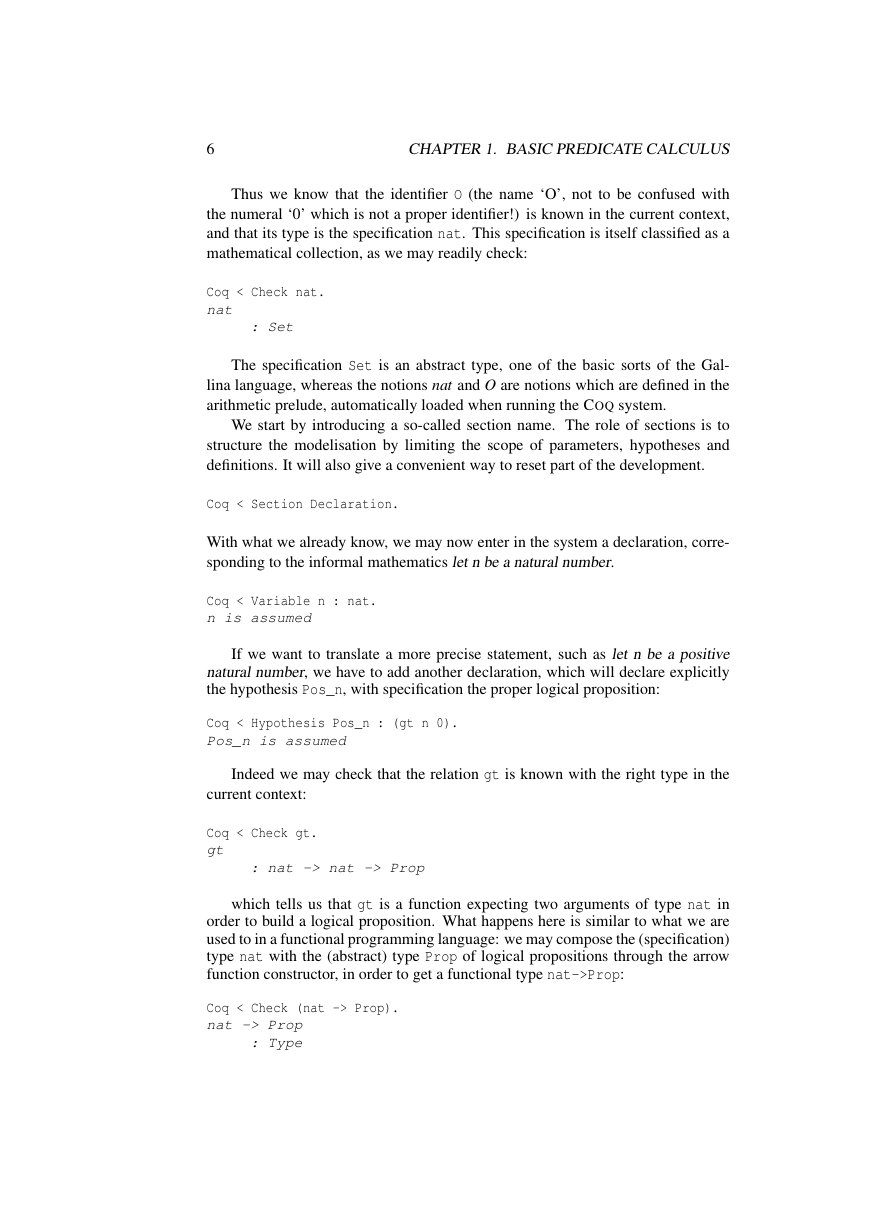
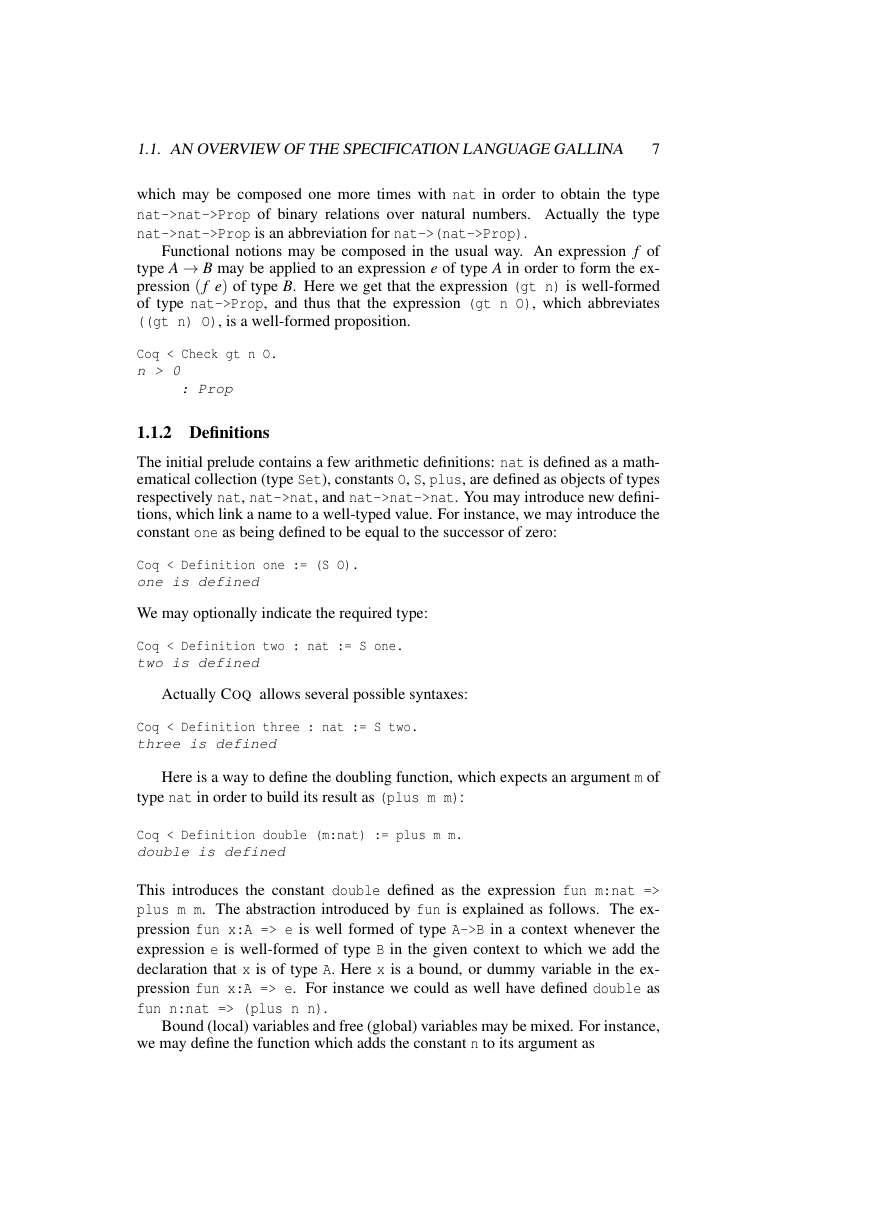
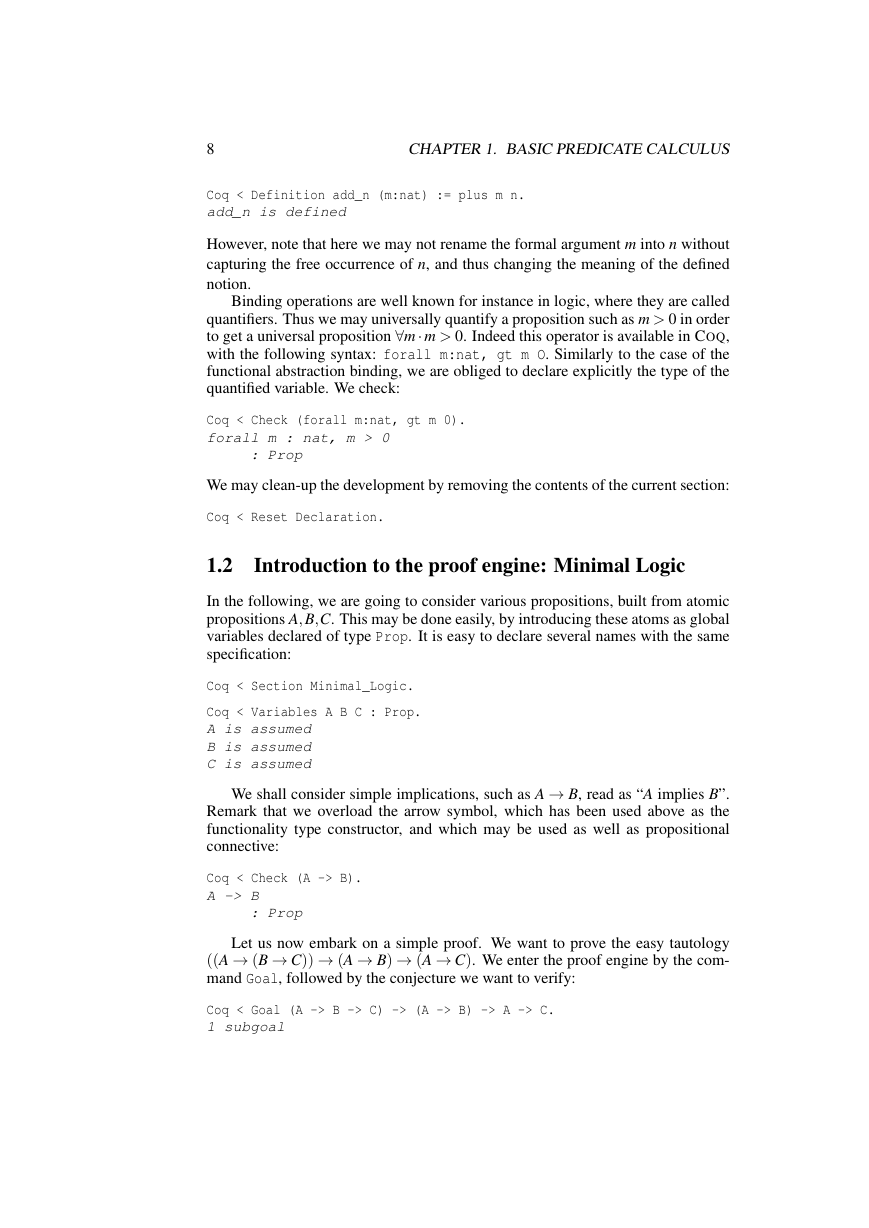








 2023年江西萍乡中考道德与法治真题及答案.doc
2023年江西萍乡中考道德与法治真题及答案.doc 2012年重庆南川中考生物真题及答案.doc
2012年重庆南川中考生物真题及答案.doc 2013年江西师范大学地理学综合及文艺理论基础考研真题.doc
2013年江西师范大学地理学综合及文艺理论基础考研真题.doc 2020年四川甘孜小升初语文真题及答案I卷.doc
2020年四川甘孜小升初语文真题及答案I卷.doc 2020年注册岩土工程师专业基础考试真题及答案.doc
2020年注册岩土工程师专业基础考试真题及答案.doc 2023-2024学年福建省厦门市九年级上学期数学月考试题及答案.doc
2023-2024学年福建省厦门市九年级上学期数学月考试题及答案.doc 2021-2022学年辽宁省沈阳市大东区九年级上学期语文期末试题及答案.doc
2021-2022学年辽宁省沈阳市大东区九年级上学期语文期末试题及答案.doc 2022-2023学年北京东城区初三第一学期物理期末试卷及答案.doc
2022-2023学年北京东城区初三第一学期物理期末试卷及答案.doc 2018上半年江西教师资格初中地理学科知识与教学能力真题及答案.doc
2018上半年江西教师资格初中地理学科知识与教学能力真题及答案.doc 2012年河北国家公务员申论考试真题及答案-省级.doc
2012年河北国家公务员申论考试真题及答案-省级.doc 2020-2021学年江苏省扬州市江都区邵樊片九年级上学期数学第一次质量检测试题及答案.doc
2020-2021学年江苏省扬州市江都区邵樊片九年级上学期数学第一次质量检测试题及答案.doc 2022下半年黑龙江教师资格证中学综合素质真题及答案.doc
2022下半年黑龙江教师资格证中学综合素质真题及答案.doc